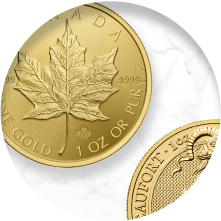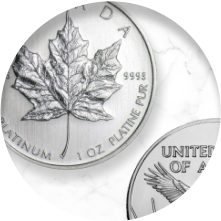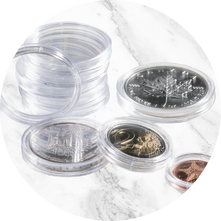Explaining the Mining Clock: Guest expert Bob Thompson - Weekly Wrap-Up (December 27, 2019)

December 27, 2019
It’s our last Weekly Wrap-Up of the year and we are excited to chat with Bob Thompson, Senior Vice President and Portfolio Manager of Raymond James in Vancouver. He’s the author of the book, “Stock Market Superstars”, and his writings and other media can be found at http://bobthompson.ca/.
It’s been a great week for precious metals even though no one is talking about it. Host Craig Hemke chats with Bob in a very insightful Weekly Wrap-Up:
- How the tax-loss selling is impacting the market
- Why all the recent economic good news is not driving gold prices down
- What are the economic projections for 2020 and beyond
- Plus, a great explanation on the “mining clock” and where are we in the cycle
Eric returns next week. Ask Eric a question by following us on Twitter ( www.twitter.com/SprottMoney) or Facebook ( www.facebook.com/SprottMoney) and post to us using the hashtag #AskEricSprott
For more info, contact us at submissions@sprottmoney.com
Man: You're listening to the "Weekly Wrap-Up" on Sprott Money News.
Craig: Well, hello again from Sprott Money News and sprottmoney.com. It's Friday, December the 27th, the last Friday of the year, and this is your last "Weekly Wrap-Up" for 2019. I'm your host Craig Hemke. Joining us this morning is not Eric Sprott. Eric is on vacation this week, so we've got a friend of Eric and a friend of Sprott Money by the name of Bob Thompson. Bob has sat in for Eric before, so it's a pleasure to have him back.
He's a senior vice president and portfolio manager with Raymond James in Vancouver. He's also the author of a great book called "Stock Market Superstars: Secrets of Canada's Top Stock Pickers" of which obviously Eric Sprott is one of them. Bob, thank you so much for your time this morning.
Bob: Hey, Craig. It's great to be with you again.
Craig: Hey, before we get started, I know it's the end of the year, but it's time to start looking ahead to January just a little bit. A lot of folks always look forward to that big Vancouver Resource Investment Conference in the middle of January, and Sprott Money is looking forward to it as well. We are jumping right into that, baby. At that conference that's coming on January the 19th and 20th this year, Sprott Money will be hosting a kickoff party on Saturday, January the 18th. If you're gonna be at the conference and you're coming in a little early, make sure you join us. You can just keep watching sprottmoney.com for more details on how you can RSVP. We'd love to see you there. Bob, are you gonna be at that conference? It's right there in Vancouver, my friend?
Bob: Hey, I'm right here and, you know, it'll be about 100 steps. I'm looking at the building right now. So, yeah, I will certainly be there. It's a great conference. I wouldn't miss it. I'll certainly be stopping by the Sprott Money booth too.
Craig: Well, I tell you what, my friend, before we move on to 2020, it has been a tremendous week for the metals and the miners, and we still got a few days left to go in 2019. As we record this on Friday, it's about noon Eastern, and the February gold is trading at 1518, that's up $37 on the week. That's more than 2% obviously. And the mark silver is trading at 1803, that's up 78 cents on the week. Bob, I'm sure you've enjoyed watching that this week. What are your thoughts?
Bob: Hey, you know, it's blowing through all these supposed resistance levels that people talk about, you know, the 1,500 psychological, and silver at 1725. So, you know, I think it's a good times there. A lot of people aren't talking about and I love that. Right in this week right here which is normally a pretty good week for the junior gold stocks as well as gold price, and, you know, nobody is talking about this. It's creeping up nicely here and it will just be great if it went up $10, $15 a day, right? You get these big days and these big drops and, you know, people are pushing the prices around and, you know, that's not good for it. I would just like it to have a sustained bid under that price and it would be really good for the sector.
You know, I don't think a lot of people realize that since the beginning of 2016, you know, this has been the best sector to be in. Everybody is still focusing on the S&P 500 but this has been the best sector to be in for the last two or three years if you look at the bottom of the beginning of 2016. I'm excited.
Craig: Yeah, absolutely. And, you know, you mentioned a little bit of the seasonality, it is certainly at least since that bottom in 2015, it seems to be an every year occurrence. We get that tax loss selling season behind this, and that's usually some time before Christmas, and then these last five, six, seven trading days of the year have been pretty good. It seems like we're seeing that again this year. I'm sure you've probably noticed that.
Bob: It is and, you know, going into the beginning of the year, I think things will just get better as you go into January. You know, when we get into the tax-less selling, you see a lot of these things. The volumes just drop right off and they go no bid, right? Nobody wants to buy. There's some selling so it pushes the price down. But, once that selling is depleted, all you need is a little bit of a bid and these things jump up 10%, 15% and we're starting to see that right now in the market.
So, with the gold price supporting that underneath and silver, you know, that just adds to it, and we're seeing a lot of green on the screen today, and for the last week, and then it gets kind of to continue.
Craig: So, Bob, obviously, it's encouraging to see the metals rallying. There's so much talk these days, at least in the last several weeks, several months now about the U.S. economy getting better, the fed allegedly being on hold and all this stuff, and people are trying to say, "Oh, yeah. Now, gold is gonna go back down." Instead here, gold is rallying. Like we talked about, the shares making new highs for the year. What do you think is causing the metals themselves to rally, and what do you think will cause an extension to this rally as we get into 2020?
Bob: You know, Craig, I think it's interesting, you're absolutely right. A lot of these things that are coming out, the economy is doing great, unemployment, or employment gains have ticked up again, all these numbers that we look at, what I think is really interesting is, you know, a few months ago, or in the last few years, these headline news events would've crushed gold, and it's not. It's actually not hurting gold and it's helping gold. So I think the market is actually looking through that and saying, "We're getting pretty close to the end of this cycle here, and if we get a few good numbers coming out here and there, it doesn't mean things are gonna get a lot better." So I think, you know, we're in the ninth inning of this stretch and the market is looking through that and really pushing up the stocks. You know, the stocks have been doing a lot better than gold and silver. Silver stocks are trading well above their near-term highs, and silver isn't up at that level yet. So, again, I think it's the market saying, you know, we're looking to the next phase here, and the next phase is that we're gonna have some wonderful gains in gold and silver.
You know, we're in the last year of the presidential cycle right now. They try to pump up the economy, try to keep rates low, they try to make everything look great. But, you know, I think doing that is like the little boy plugging the hole in the dike. It's getting easy. There's more and more holes and he's trying to plug them faster, and faster, and faster. And when this all ends, the dike just collapses in that much harder, and I think that's kind of what the market is looking at right now.
And, Bob, into 2020, you know, I remember seeing a report, I don't know, a week, two weeks ago. I think Eric and I might have spoken about it last week from the U.S. Congressional Budget Office, I mean, $1.2 trillion annual deficits as far as the eye can see with no recessions ever forecast to affect revenues. You've got the total treasury issuance next year that someone is gonna have to buy obviously. The fed is monetizing about half of it. Are those some of the factors you think will drive prices next year?
Bob: Well, yeah, you know, interesting, I was looking at the CVO's economic projections from 2019 to 2029, that's what I do over the holidays, it's really fun stuff. But, I see that the nominal GDP is expected to basically average almost 4% for the next 10 years with no recessions along the way, 4% nominal GDP, and a $1.2 trillion deficit. So, if you can imagine, if we just get one or two years in there of a recession, how that number is gonna spike and how these numbers all change, the worst thing we do in the financial industry here is we extrapolate out. What's happened in the near past, we extrapolate that out to the future, and it's the worst possible thing that we can do.
You know, on the other hand, if the CBO comes out and says there's gonna be a recession in 2022 and it's gonna be a nasty one, guess what's gonna happen? There's gonna be a nasty recession in 2022. So, they basically never say there's gonna be a recession because that's gonna cause a recession to happen at that time. So, you know, looking at these numbers and looking at the fact that projections never work out the way they say they're gonna work out. You know, the fed dot projection, how many times they're gonna raise rates, it never works out. It's always wrong. I think that's really gonna underpin gold and I think the market is really starting to see that.
Of course, silver is gold on steroids later on in the market, and we can talk about that a little bit later. But at the beginning here, gold and silver are kind of up the same this year. You know, I think gold is, what do we got? Probably up around 18% for the year right now. Silver is up around 15. That's normal as we get later on in the cycle, you know, silver wraps up and, you know, goes up double or gold does a lot of times.
Craig: Well, you know, that's a good point, because a lot of folks have been frustrated so far by silver this year because gold is up 18%, 19% but silver is not even up that much. Still having the best year since 2010, but do you expect a little bit of a flip of that type of performance next year?
Bob: Well, that brings up a good point about this market right now and kind of where we are, because I think we're probably, you know, through that first phase of this bull market, which people don't even know we're in a bull market because they're still focusing on the S&P 500 and they're still focusing on, you know, all the tech stocks that are going up and that sort of thing. Reminds me a lot of 1999. But in that first phase, you start to see, you know, gold and silver rally, the stocks do but no one is paying attention.
And as we get later on in the cycle, probably into the last third of the cycle, people say, "Wow, this is a precious metal's bull market. You know, the other markets have all rolled over." And then you start to see silver, which is actually an astonishingly small market in the world. You start to see just a little bit of money come in there and the prices go ballistic. So, yeah, I think people have to hold out and say, you know, "I'm a true believer," and I think most of the people that listen to this call on a weekly basis are true believers about the metals, and true believers are gonna stick this out and realize that silver is gonna outperform as we get further on in the market.
Craig: All right. So, Bob, as we wrap up this week, let's talk about the shares. It has been a tremendous move in the shares. The HUI index is up maybe 15%, 18% since October. Now at the highs of the year, you've got your own, I guess we'll call it indicator that you follow, you call it a mining clock, that kind of shows where you are in a cycle and which sector of the shares might perform the best. Where do you think we are in that clock right now? Maybe you can explain a little bit about how that works.
Bob: Yeah. Well, you know, I think it's fascinating and I've mentioned this to a lot of the senior people in the mining sector, and very few people have heard of it. I think it actually originated in South Africa, a company that started it there, but I've talked to a lot about it because it helps to visualize where we are in the cycle because this is extremely cyclical. You know, when I did my book and I interviewed Erik Erikson, "I love the mining sector," he said, "because the lows are so low and the highs are so high. The difference between the highs and the lows is hundreds of percent, and there's no other sector in the world that's like that."
Knowing that, it's really important to know where you are in the cycle so we don't do the round trip again. So, let's take a look at 1:00 on the mining clock, that's usually right after the peak in the market. That's the initial shock, metals prices start to go down. Companies who had extrapolated out what had happened in the good years start to see, "Oh my god. Things are not working out the way we did. Metals prices are down a lot. We've got leverage on the downside," so they have to start cutting cost.
We get to around 3:00 on the mining clock and you've got company liquidations. Remember the big companies at the end of 2015, the Glencores of the world, super giants. We're right on the brink with their debt. They almost went under. So you start to see these liquidations. You start to see companies get rid of assets. You start to see the smart operators come in who have some money, they'll buy from the big companies. Dividends cut, you get assets written down.
Then we get to 4:00 and the industry recaps. You know, prices tend to stabilize. Metals prices tend to stabilize. That was probably 2013, 2014 into 2015 and you get a recap of the industry. Interestingly, what you first start to see in the sectors, the big companies who were in trouble, they don't have a pipeline anymore. You know, if somebody is producing 5 million ounces of gold a year and they have 30 million ounces of reserves, they don't have a company in six years unless they go and get some more gold.
So you start to see cash takeovers. And we've seen that. We saw that at the beginning of 2016. You start to see companies do cautious buying. And you start to see a little bit of M&A in the sector. And in the last few weeks, we've really seen, you know, about seven and a half billion of M&A in the sector. A lot of it is cash buyouts. Some of the big ones will be stock buyouts. You see debt start to fall. And then you get down around 6:00 and I think that's approximately where we are right now, 6:00 or 6:30 in the mining clock.
You know, from 12:00 until 3:00 is disastrous. That's horrible for the industry. Right around 4:00 is the buy time when you should start to buy and that was in 2016. We're on 6:30 right now. And what we haven't seen is a lot of junior IPOs of stocks. That happens around 7:00 or 7:30. So, that's why I think we're around 6:30. We've seen a tremendous amount of private placements, some big investors in the country has been buying a lot this year in private placements but not as far as traditional junior IPOs.
We haven't really seen exploration rise to a significant extreme yet. That happens around 8:00. Around 9:00, companies start to increase their debt again, and you start to get paper takeovers of stock. Now, depending upon where you live, you know, here in Canada we've had a big cannabis rally, right? Cannabis stocks have gone through the roof in the past few years. And what we started to see in the last few months, which told me that we were near the end of the cycle is we started to see paper takeovers. So, companies would use their stock to buy somebody else's stock. And they were very, very high-priced stock. And that usually, what happens at the end of the cycle, it doesn't matter whether it's cannabis, it doesn't matter whether it's mining, or technology, you start to see that happen.
Then you start to see some aggressive selling around 11:00. And just before the crash, as always, guess what happens, the governments raise taxes just before the crash. Because they see all the money that's been made, all the relative they've missed out on and the good times, so they raised taxes which just makes the crash even worse, and here we go with the cycle again. So, I think, you know, it's good to know where you are in the cycle, and it's good for us to know right now that where I think we're still in that first third of the cycle. And if I could just mention something that Erik told me years ago, you know, and why I think why he's been so successful. He said, you know, he gave an analogy. He said, "You have to be sitting in the room by yourself having a party." And he said, "What that means is you're buying lots of stock in an industry that everybody hates for the time being." And he said, "That's the only way that you're ever gonna get these big games when they happen with the cycle." And he said, "It's an awful lonely place to be sitting in the room having a party by yourself when everybody is partying in the other room."
Everybody is partying, buying the tech stocks, buying high-priced S&P 500 companies, etc. But he told me, he said, "You've got to have your position before everybody decides it's time to party in your room, because once everybody decides it's time to party in your room," he said, "The bar is awful small to get through, and it's a bloodbath to get through that door, and the prices go through the roof." And he said, "That's where you got to be. It's a lonely place but you got to be by yourself there." And I think, you know, with this last two or three years, you look at the prices, they've been doing well, but it's been a lonely place. And I like to be in lonely places because it means I'm right usually.
Craig: That's right, that's right. Bob, that's great stuff and extraordinarily valuable information. Anything else on your mind before we wrap up?
Bob: You know, not really. All I wanna say is, you know, the market is gonna try to shake you all a lot of times, and like I said, you've got to be a true believer. You know, and if you're a true believer, the market isn't gonna make you do unforced errors, right? You know, we had a nice correction in the summer here, a lot of people could've said who didn't understand the sector could've said, "Okay. I'm out. A lot of these stocks are down 20%, 25%." But if you're a true believer, you're gonna be there and you're gonna stick with it and understand that we're in a pretty good bull market here and we're probably in the first third of it.
Craig: Sounds good to me. Hey, one more thing I'll add too on this end, if you recall, we discussed last week how Erik was the guest for "Ask The Expert" this month which you can find at the sprottmoney.com website. And we broke that thing up into two parts, so we could get as many of your questions answered as possible. The first part was about gold and the gold mining sector. Part two, which is due to be released at some point later today, December 27th, focuses on silver. And I think if you wanna hear some more about the silver miners and a little more about maybe some specific companies in that sector, please check back to sprottmoney.com. Click the insights tab and you'll find Ask The Expert there. And give a listen. There are other great interviews there from Jim Rickards, Nomi Prins, even Brent Cook last month. So, please be sure to check it out. We've been, again, speaking with Bob Thompson. Bob is senior vice president and a portfolio manager at Raymond James in Vancouver. Great stuff, Bob. Really, really appreciate it.
Bob: Thanks again, Craig, and Happy New Year.
Craig: Happy New Year to you, my friend, and to everyone listening. Happy new year as well. We look forward to a great 2020. And please be sure to visit sprottmoney.com for all your gold and silver bullion needs. We'll talk to you again next Friday.
Don’t miss a golden opportunity.
Now that you’ve gained a deeper understanding about gold, it’s time to browse our selection of gold bars, coins, or exclusive Sprott Gold wafers.
About Sprott Money
Specializing in the sale of bullion, bullion storage and precious metals registered investments, there’s a reason Sprott Money is called “The Most Trusted Name in Precious Metals”.
Since 2008, our customers have trusted us to provide guidance, education, and superior customer service as we help build their holdings in precious metals—no matter the size of the portfolio. Chairman, Eric Sprott, and President, Larisa Sprott, are proud to head up one of the most well-known and reputable precious metal firms in North America. Learn more about Sprott Money.
Learn More
You Might Also Like:

















Comments